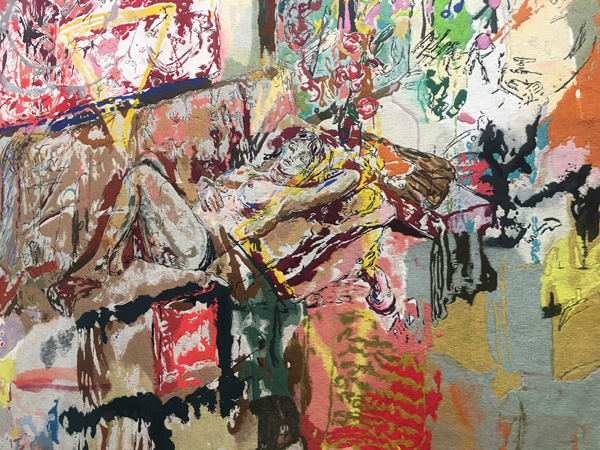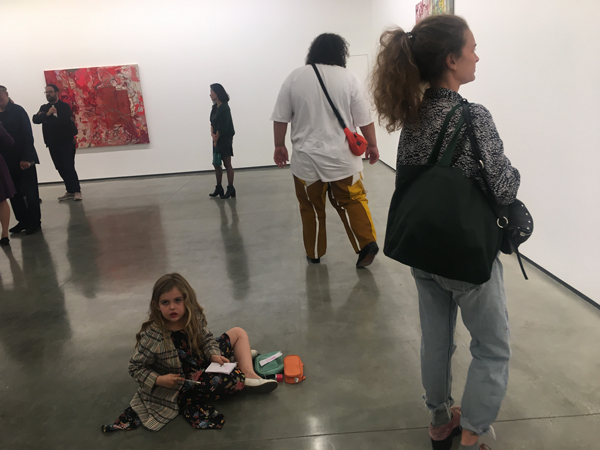David Kordansky Gallery’s opening this past Saturday featuring the work of Ivan Morley and Ricky Swallow was a full house–and well worthy of the audience.
A line of cars built up to the gallery, making it clear from the get-go that Kordansky was an anticipated stop for many. Strolling through doors, we were enveloped in a bustling crowd, all of whom were excited to see Morley’s paintings in “Olvera St.,” and Swallow’s exhibition of sculptures for his show “Shoulders.”

Ivan Morely, Fandango, detail
Morley’s paintings drew us into the first room with their intrinsically appealing color, texture and narrative. Most of the paintings in were not merely paint on canvas, but rather extended into use of materials such as leather, glass and embroidered canvases. An eclectic array for sure, but together the works weaved a narrative alluding to cultural shifts in Los Angeles over the last 200 years. The actually DTLA Olvera Street served as the artist’ main inspiration as it was considered the first street of downtown and where artists such as Philip Guston and Jackson Pollock resided. Morley utilizes symbols of social life, food and color from imagined stories from the street’s early years as well as personal anecdotes. This combination of playful storytelling, allows us to consider how streets of the past have led into ours today. Morley’s personal investment in the intricate pieces was obvious. This became even more evident when I talked to the artist about his process for the embroidered work, which fluctuated between drawing and working on a sewing machine. When asked if these woven works were paintings the artist was certain, reflecting that although some consider them to be tapestries, once stretched and pulled together, they truly become paintings. Morley’s work contained as much ornamental quality as subtle intricacies, allowing us to consider how memories are stitched together and inevitably distort over time. In the mind’s eye, a past moment may exist as a vibrant mapped-out picture, but when reflected upon deeper, one remembers that more lies underneath, just as in Morley’s paintings.

Swallow floor sculpture
The next room of Swallow’s whimsical, yet intentionally curated sculptures invited viewers into a display of poetic and animated composition. The cast bronze works remained static yet were displayed in a nuanced way that alluded to movement. The negative space between the works and the wall or the floor created a tension which hinted at a calm before the storm—an inhale before a fall. The theme of suspension of gravity extended beyond the work as I witnessed a mesmerized viewer whose attention was absorbed by one piece on the wall, almost trip on a piece in front of him on the floor—thankfully an attentive gallery monitor saved him and the piece. Swallow’s challenge of sculptural presentation through lack of pedestals was my favorite element of the show. The mysterious objects existed as if holding themselves rather than a need for traditional display support. I briefly engaged with the popular artist who graciously took a moment to talk about the work’s connection to Shaker culture as well as the sculptures’ tensions between movement and stillness, which became heighten when relocated from studio to gallery.

Budding young artist…
The opening remained occupied throughout the evening with a continuous energy. Invested gallerygoers seasoned in the art world remained stimulated by the work and merriment as well as those just beginning, such as a young girl who remained settled on the floor in front of one of the works with a set of markers and a sketchbook, inspired to conduct her own masterpiece.


